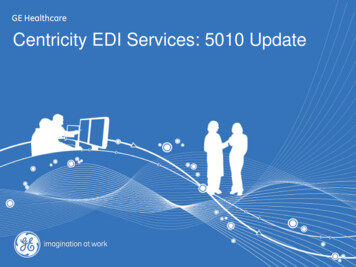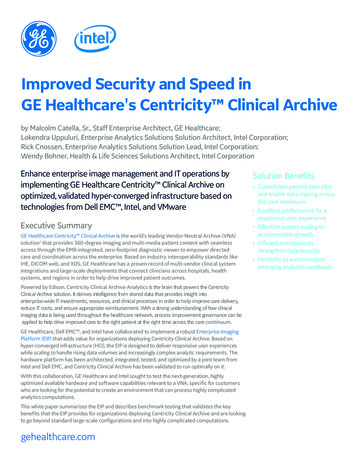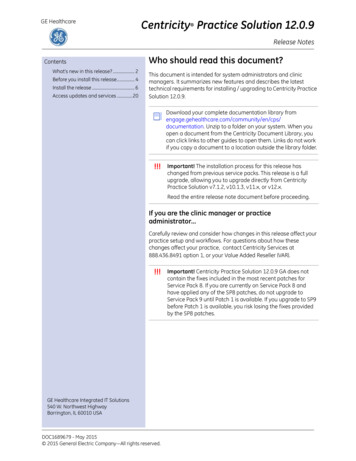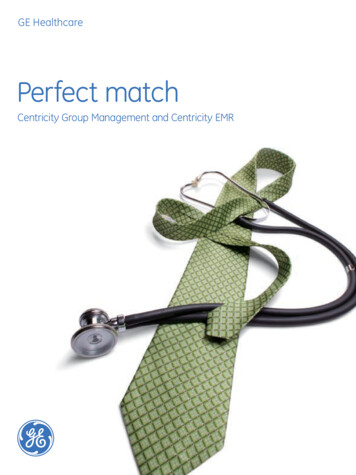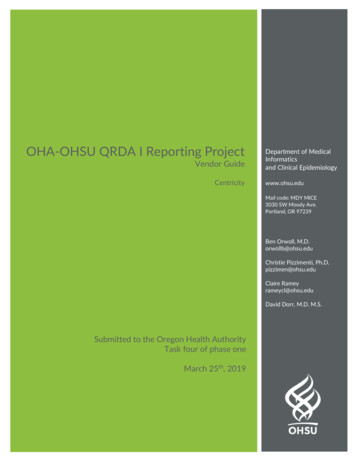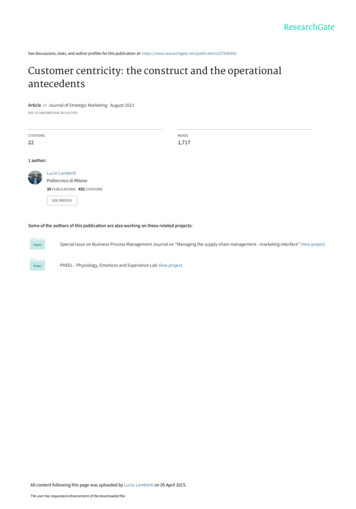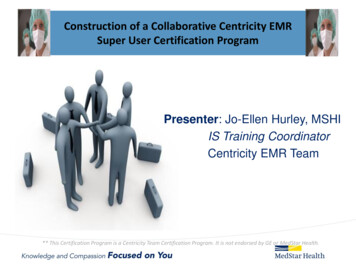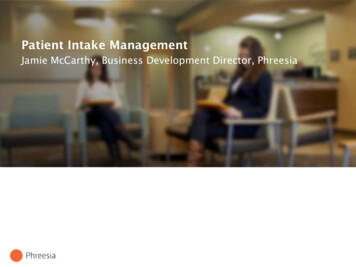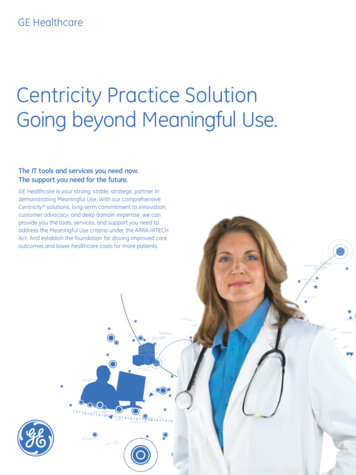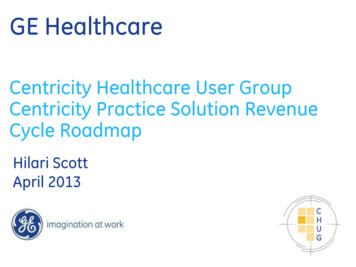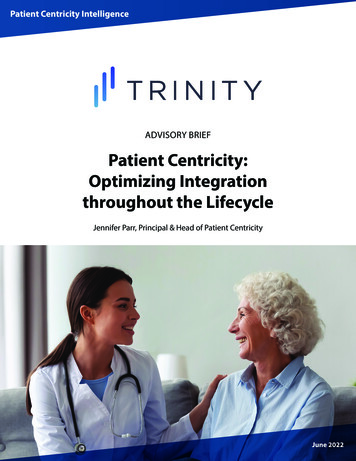
Transcription
Patient Centricity IntelligenceADVISORY BRIEFPatient Centricity:Optimizing Integrationthroughout the LifecycleJennifer Parr, Principal & Head of Patient CentricityJune 2022
Advisory Brief Patient Centricity: Optimizing IntegrationThe importance of keeping the patient voice central to decision-making has beenaccepted as a critical business issue for pharma leaders for quite some time.While the vision and goal of patientcentricity are clear, today’s leading lifescience companies are grappling withthe complexities of execution: How totake the “idea” of patient centricity andtranslate it into strategy and tactics—and how to measure results.Some of the most common questions wehear from our clients include:» Which patient data sources are mostimportant when?» What is the best way to collect andintegrate the patient voice?» Where are the real stresses in the patientexperience?» How can we integrate patient centricityin ways that are meaningful across thebusiness?» In regard to product development, whenshould thinking about the patient start?Over time, a variety of factors haveconverged to drive this focus on thepatient:» New products are more complexand “high-touch”—often requiringthe participation of multiplespecialists, new methods ofadministration, complicatedfinancial requirements andtherefore higher education andsupport needs for patients.» In their everyday lives, patientsare used to having a smooth,easy customer experience withrecognized goods and servicesbrands—and can feel frustratedand disconnected when healthcareprovides a lower level of service.» As patient choice (via a widerarray of treatments, even in nicheindications) and overall diseaseawareness (via social media andother channels) have grown,patient engagement is becoming adifferentiator in driving long-termcompliance and quality outcomes.2
Advisory Brief Patient Centricity: Optimizing IntegrationTo support our clients in executing their visions for Patient Centricity, we have developed the Trinity Patient CentricityExecution Model to clearly identify key points for patient engagement throughout the product development cycle. Thismodel acknowledges that the patient voice—wants, needs, challenges and frustrations—must be integrated into everyphase of the product lifecycle, as well as across every function and department. To help life science leaders translatevision into reality, the model provides concrete steps in the form of patient insights development, data analyses andinternal/external benchmarking.Trinity Patient Centricity Execution ModelUNDERSTAND & TARGET PATIENT NEEDSR&DGOALS Feed R&D with patient insights to guide earlydevelopment efforts Expose R&D teams to real patient stories that illustrateunmet needs and burden of illnessTACTICS Patient Ad Boards Literate/public data reviews Patient Unmet Needs StudiesDESIGN TRIALS AROUND THE PATIENTCLINICALTRIALSGOALS Ensure protocols are sensitive to patient burden (in travellogistics, enrollment process, etc.) Develop recruiting tactics and materials that resonate withpatients and reflect their motivationsTACTICS Patient Ad Boards Recruiting materials testing & refinement Patient Finding Patient JourneyPREPARE THE MARKET TO TREAT PATIENTSPRELAUNCHGOALS Identify and mitigate barriers to treatment across theentire patient journey Build awareness of patient needs and burden of illness inall relevant communitiesTACTICS Patient Journey & Buying Process PSP & Advocacy Strategies Advocacy Strategy Burden of Illness studies Marketing materials testing & refinementMAINTAIN ENGAGEMENT TO DRIVE OUTCOMESIN-LINEBRANDSGOALS Define satisfaction and engagement as they exist for thepatient and align the data sources needed to track them Continually refine strategy to drive engagement andcorrect for gapsTACTICS Continual Patient Satisfaction tracking Data Strategy Internal alignment to address gapsNote: tactics shown are not exhaustive13
Advisory Brief Patient Centricity: Optimizing IntegrationTrinity defines Patient Centricity as incorporating the “patient voice” into all aspects of decision making, from very earlyin the development cycle to launch and beyond.INCORPORATING THE PATIENT VOICE AS EARLY AS POSSIBLE DRIVES ORGANIZATION-WIDE PATIENT FOCUSStarting the collection and dissemination of patient insights in the pre-clinical setting ensures that thepatient has a seat at the table throughout the entire development process to follow. Rooting R&D teamsin an understanding of the patient experience, burden of illness and unmet clinical need also has thepractical implication of helping teams optimize Target Product Profiles (TPPs) according to patient need.DESIGNING TRIAL PROTOCOLS AROUND THE PATIENT DRIVES INTEREST AND ENGAGEMENTCo-creating trial protocols with patients ensures that the organization is ready to address any questionsor concerns that patients may have—and helps ensure the trial requirements are suitable andachievable for the patient population (i.e., not an undue burden). Additionally, patient input is criticalfor the development of recruiting approaches and materials that speak directly to patients’ needs andmotivations for participating.PRE-LAUNCH, FOCUS ON PAVING THE WAY AND PREPARING THE MARKETPrior to launch, organizations typically engage in a flurry of insight-generation activities, many of whichare focused on the patient. When the volume of information gets overwhelming, centering aroundthe critical patient-related leverage points in the market can help teams set priorities. In-depth PatientJourney work integrating a range of data sources (qualitative and quantitative patient and HCP research,RWE, patient chart abstraction, social media listening, etc.) is a core activity at this juncture, and shouldbe structured to lead seamlessly from insights to strategy and tactics.LONG-TERM, DEFINE AND MAINTAIN PATIENT SATISFACTIONFollowing launch, understanding and managing to what patient’s value is the clearest path tomaintaining long-term engagement, robust compliance and high-quality outcomes. Re-visitingthe Patient Journey continuously to examine the actual “on-treatment experience” will help identifygaps and leakage points that can be adjusted in real-time. Executing on this objective can requiresophisticated integration of multiple data sources (including the organization’s own Hub data, SP data,claims data, etc.)--and periodic touchpoints with actual patients through targeted market research.4
Advisory Brief Patient Centricity: Optimizing IntegrationPatient centricity should exist across the organization, in additionto across the lifecycleThe Trinity Patient Centricity Execution Model is a helpful tool to identify areas where the patient voice should contributeto strategy. Further, organizations also need to look internally to ensure a consistent focus on the patient acrossfunctional groups. Results of such an initiative can include measurable, patient-related KPI goals across the organizationthat drive accountability for all functions.In order to be most effective, organizations should also consider how to integrate patient-centric thinking into areas thatdon’t directly touch the patient—like hiring and sales. Hiring practices can involve some level of patient awareness andconsideration, while sales organizations should ensure that all HCP-facing staff have an empathetic view of the unmetneeds and burden of illness of the treatment areas they are working in.Patient Centricity Key TakeawaysThere are concrete actions everyone striving to integrate patientcentricity into their business decisions and workflow can do:»Drive an institutional mindset to ensure that the patient is at theheart of your decision-making»Find opportunities to work the patient voice into areas of theorganization that don’t typically interface directly with patients(HR, Sales, Market Access, etc.)»Develop patient-centric KPIs, like outcomes and metrics, thattruly represent patient satisfaction—and evaluate/incent theorganization with them»Track against those KPIs and refine your patient engagementstrategy accordingly as insights and understanding evolve5
Advisory Brief Patient Centricity: Optimizing IntegrationAuthorJennifer Parr Principal & Head of Patient CentricityJennifer currently leads Trinity’s Patient Centricity Center of Excellence, helping Trinity’s clients weavethe Voice of the Patient into all facets of the product lifecycle. Jennifer’s group works closely withTrinity’s Strategic Advisory, PMR and RWE teams to produce deep patient insights based in real-worlddata, that are tactically actionable for a wide range of biopharma customers. Over the past 9 yearsat Trinity, Jennifer has helped clients leverage patient insights in a wide array of treatment areas,including Oncology, GI, and several orphan and neuromuscular diseases.Jennifer has been involved in patient and consumer insights work for the past 18 years, with priorroles at Forrester Research, Quintiles Consulting and Applied Marketing Science. Having joined Trinityin 2010, Jennifer helped develop the company’s primary research capabilities into a core part of thebusiness, specifically in the areas of qualitative research and Patient Journey.Jennifer earned a BA in Psychology from Boston University. When not at the office, Jennifer is mostlikely planning the next family vacation for her husband and 3 school-aged kids, plotting her nexthome improvement endeavor, or being entertained by her extremely active boxer puppy, Ruby.6
About Trinity Patient CentricityTrinity Patient Centricity focuses on deeply understanding patient needs andexperiences to support life science organizations in product development, launchand beyond. Patient-centric insights and analytics are more relevant than ever,even as inputs grow in complexity and outputs grow in importance. Trinity’spatient-centric suite of offerings include integrated, tech-enabled servicespowered by unique, time-tested methodologies and dedicated teams of MarketResearchers, RWE Experts and experienced Strategic Advisors. To learn moreabout how Trinity Patient Centricity helps clients turn patient-level data andinsights into strategic direction for patient-centric decision-making, click here.For more information, please contact us at omCopyright 2022 Trinity. All rights reserved.
About Trinity Patient Centricity Trinity Patient Centricity focuses on deeply understanding patient needs and experiences to support life science organizations in product development, launch and beyond. Patient-centric insights and analytics are more relevant than ever, even as inputs grow in complexity and outputs grow in importance. Trinity's
